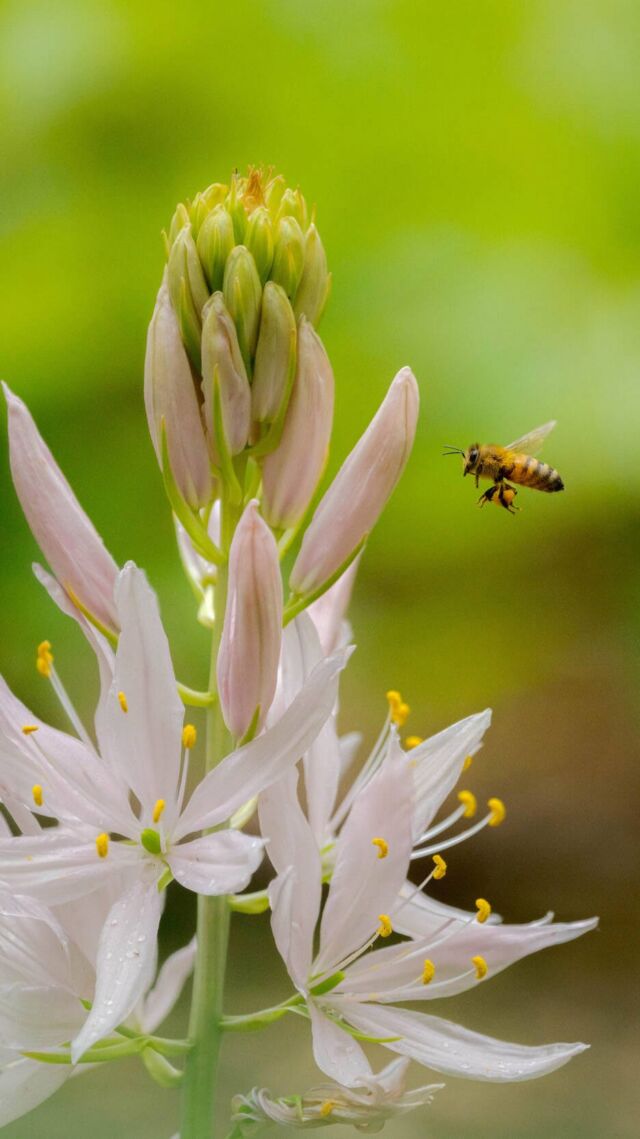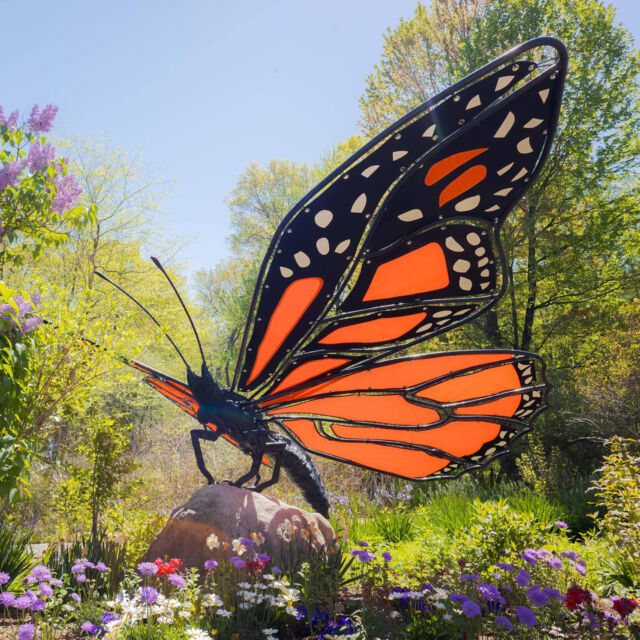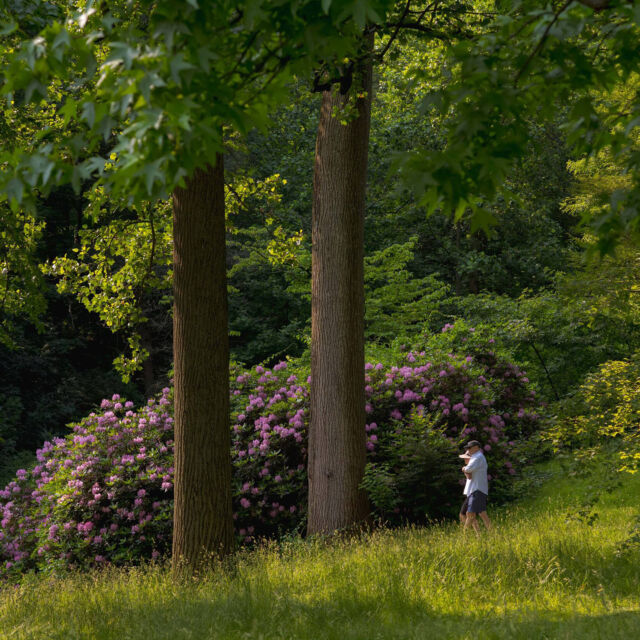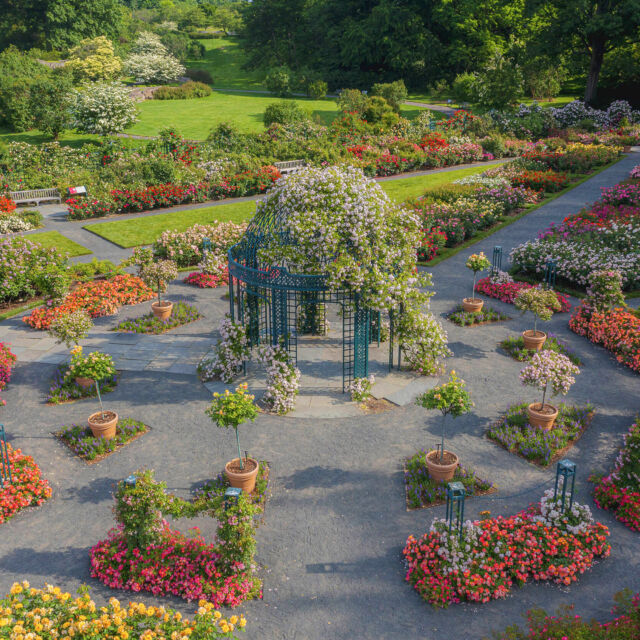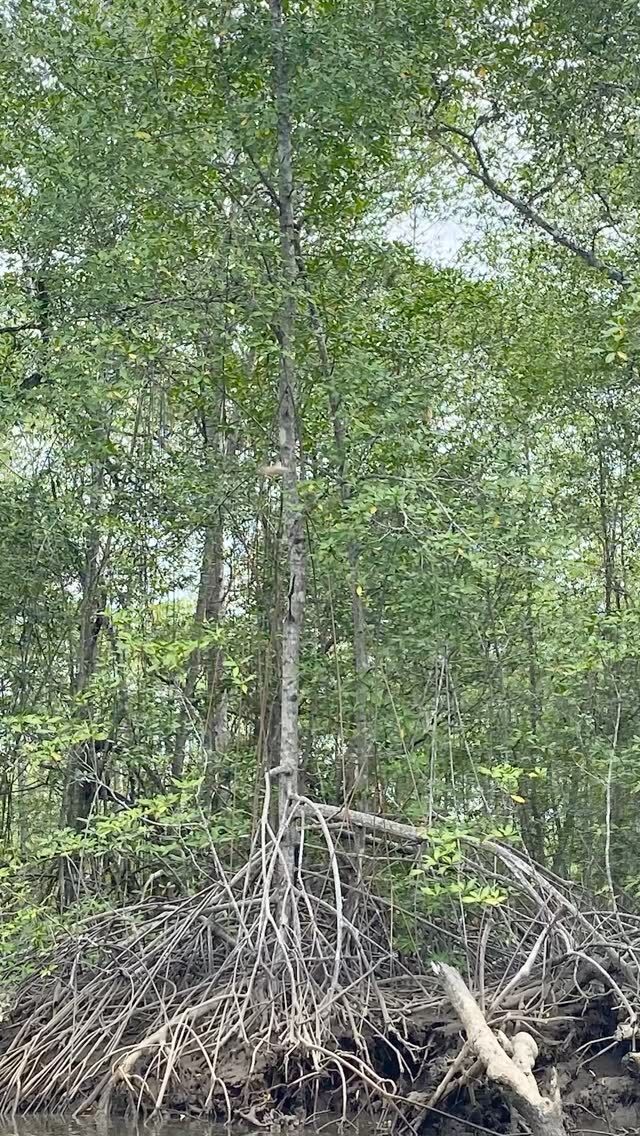Moving Toward Peace with Nature: NYBG at COP16
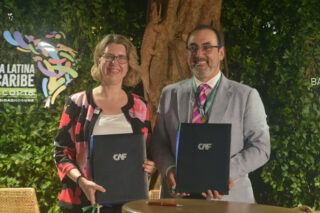
Jennifer Bernstein, CEO & The William C. Steere Sr. President, with Sergio Díaz-Granados, the head of the Development Bank of Latin America and the Caribbean (CAF), both holding copies of the collaboration agreement signed at COP16.
“The scientists at The New York Botanical Garden look to plants for the answers in advancing real-world solutions around conservation, restoration, land use, regenerative agriculture, and plants, people and culture,” said Mauricio Diazgranados, Ph.D., NYBG’s Chief Science Officer and Dean of Science.
This year’s biennial UN Biodiversity Conference, known as COP16, wrapped up on Saturday after two weeks of discussion. Hosted in Cali, Colombia, COP16 was attended by delegates from over 180 countries, who met for discussions and negotiations with the underlying theme of “Peace with Nature.” Among those delegates was a group from NYBG, including Jennifer Bernstein, CEO & The William C. Steere Sr. President; Mauricio Diazgranados, Ph.D., Chief Science Officer and Dean of Science; Eric Sanderson, Ph.D., Vice President for Urban Conservation; Aleca Borsuk, Ph.D., Assistant Curator, who is a specialist in plant structure and function; and Evelyn Beaury, Ph.D., Assistant Curator, a specialist in invasive species and global change.
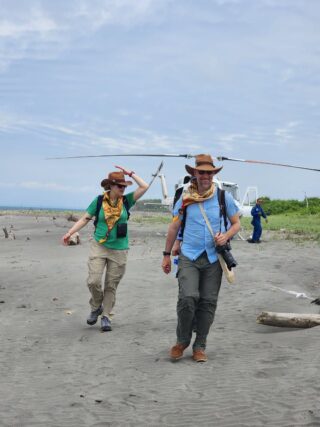
While at COP16, members of NYBG’s delegation, including Jennifer Bernstein, CEO & The William C. Steere Sr. President, and Mauricio Diazgranados, Chief Science Officer and Dean of Science, traveled to the biodiverse state of Nariño in western Colombia.
COP16 built upon the outcome of 2022’s COP15—the Kunming-Montreal Global Biodiversity Framework (GBF), also known as The Biodiversity Plan for Life on Earth, which established a pathway to reach harmony with nature by 2050. This includes 4 goals for 2050 and 23 targets for 2030, especially the notable “30×30” goal to conserve 30 percent of Earth’s land, freshwater, and oceans by 2030, as well as reducing invasive species by 50 percent by 2030. At COP16, countries reviewed progress and focused their attention on action and implementation of the GBF. According to The New York Times, COP16 ended with two breakthroughs that would shift profits from companies who profit from genetic information into a fund that would support global conservation efforts and established rights for indigenous people, who received a permanent body for future negotiations. However, the conference concluded without a clear path for biodiversity funding, monitoring targets, and implementation plans for the Global Biodiversity Framework.
Earth is currently undergoing what has been referred to as a “triple planetary crisis,” which refers to climate change, pollution, and biodiversity loss. Alarming numbers have been circulating in the midst of COP16 discussions: 75 percent of Earth’s land surface and 66 percent of its oceans have been altered by human activities, according to UN Secretary-General António Guterres. More than a third of the world’s tree species are threatened by extinction, according to the first comprehensive assessment of trees.
Of the 166,061 total species assessed by the International Union for Conservation of Nature (IUCN) Red List, 28 percent, or 46,337, are threatened.
Though plants are threatened globally, they can also provide solutions for our shared environment. Botanical gardens are important for plant conservation, especially endangered species. They are also critical pillars of education, advocacy, and research—to understand how plant life has changed and how we can best preserve it. When botanical gardens work together, they can strengthen and scale their reach and impact in plant conservation.
NYBG’s location in New York City makes it all the more important as a hub of biodiversity, conservation, and recreation within an urban area.
“Urban conservation is important for biodiversity because those cities are in places of such high biological potential,” said Dr. Sanderson at an event on October 27 during COP16 hosted by the Development Bank of Latin America and the Caribbean (CAF). “The way we think about nature, the way we live with nature in our cities has repercussions far beyond the boundaries of the city.”
He also noted that cities must recognize their vital role in protecting the environment and join forces to do so.
“There’s a responsibility, therefore, for all of us who live in cities to try to get this right,” said Dr. Sanderson. “The world has been urbanizing, cities are habitats for people…not only that, but the economic flows…through cities are important for the decisions that get made in those cities, and for nature everywhere else.”
NYBG at COP16
![nariño fieldtrip journalists 10.25.24[100]](https://www.nybg.org/content/uploads/2024/10/Narino_Fieldtrip_journalists_10.25.24100-320x240.jpeg)
During the NYBG team’s trip to Nariño, Mauricio Diazgranados, Chief Science Officer and Dean of Science, spoke to reporters as they visited a páramo, a high-altitude ecosystem known for its distinctive frailejón plants. Jennifer Bernstein, CEO & The William C. Steere Sr. President, and Evelyn Beaury, Assistant Curator, are pictured to the right.
NYBG brought together its own scientists and other leading experts for two plant-focused COP events, on October 22 and 28, and participated in a field trip to the state of Nariño, a biodiverse hotspot, to shed light on the great need for research and conservation in the region.
The first event, The Role of Botanical Gardens in Addressing the Triple Planetary Crisis, included scientists from Botanic Gardens Conservation International, a global network for plant conservation, of which NYBG is a leading member; the Bogotá Botanical Garden, which co-hosted the event; and Dr. Diazgranados. They spoke about how botanical gardens are not only currently combating climate change and upholding conservation efforts but also how collaborations can be strengthened and scaled to address wider environmental issues.
The second panel discussion, Challenges and Opportunities of Using Plant-based Solutions for Addressing the Climate and Biodiversity Crises, was held at the Cali Botanical Garden and featured presentations by Drs. Borsuk and Beaury. Dr. Sanderson moderated the discussion.
Members of the NYBG delegation also had speaking engagements throughout the conference and lent their expertise at other events that highlighted a range of topics, such as agrobiodiversity, financing sustainable cities, and food quality.
There have always been barriers to progress at COPs, especially the impasse that results from countries’ conflicting individual interests and unequal resources. This year’s is no different. However, initiatives led by institutions like NYBG give reason for hope.
In what was likely the high point of an eventful two weeks, NYBG and CAF signed an agreement to develop research on biodiversity, including bio-based development, and to promote restoration strategies that will apply NYBG’s resources and expertise in strengthening cross-sector conservation efforts in the region. This is the first agreement the bank has signed with a botanical garden and is a significant new partnership opportunity for NYBG.
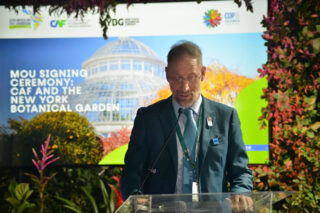
Mauricio Diazgranados, Chief Science Officer and Dean of Science, speaks at the signing ceremony for NYBG’s new collaboration with CAF.
“We believe that it’s important for institutions like ours to collaborate with innovative, forward-looking partners like CAF that focus on biodiversity,” said Jennifer Bernstein of the agreement. “Botanical gardens have a vital role to play in global efforts to combat the dual climate and biodiversity crises and can contribute meaningfully to potential solutions.”
COP16 called for countries to turn promises into action—to commit to funding, implementation and governance surrounding biodiversity. The conference—also referred to by the Colombian government as “la COP de la gente,” or the COP of the people, not only focused on biodiversity conservation but also emphasized the role of Indigenous communities, local groups, women, and minorities in protecting the environment.
Although the dual climate and biodiversity crises are complex, one thing is clear: people need plants, plants need people—and NYBG is committed to helping both with actionable, nature based solutions to ensure a green future.
Want to learn more? Visit the COP16 webpage or sign up for information on environmental action at NYBG.
Challenges and Opportunities of Using Plant-based Solutions for Addressing the Climate and Biodiversity Crises was made possible thanks in part to the generous support of the Gordon and Betty Moore Foundation.
SUBSCRIBE
Enter your email address to subscribe to this blog and receive updates on new posts.


